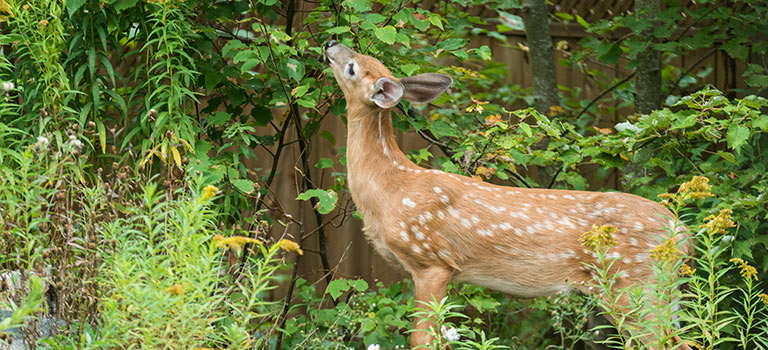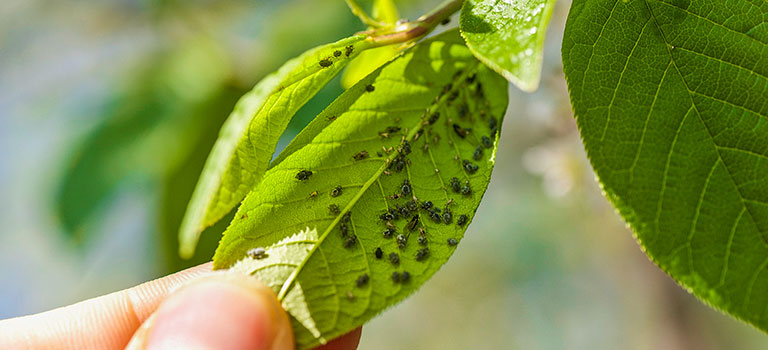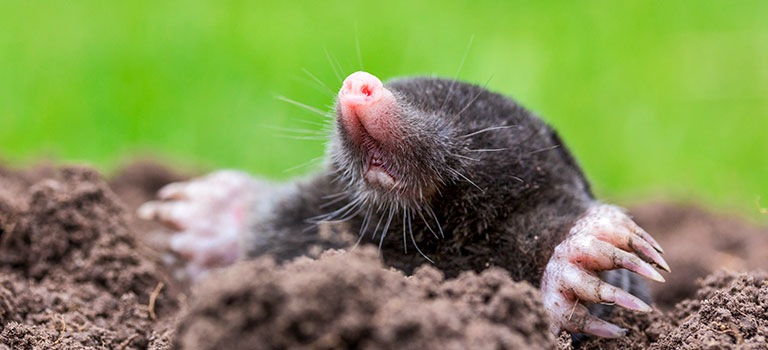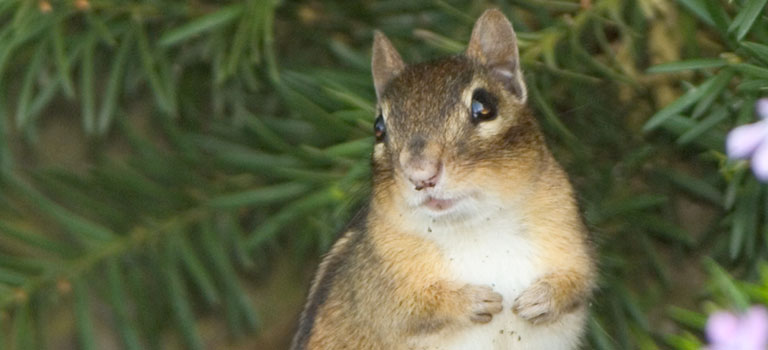
Most garden visitors are either beneficial—like bees and ladybugs—or relatively harmless, nibbling at plants a bit without truly hurting them.
But some animals, insects and other creatures can cause serious, even permanent damage to your flower garden, so it is necessary to keep them away from your plants and bulbs.
The keys are knowing which pests to look for and deciding how best to control them. The Old Farmer’s Almanac offers some suggestions, and we have added a few of our own.
APHIDS

These tiny bugs feed on nutrient-rich liquids found in plants, attacking leaves, stems, buds and flowers, and are particularly destructive in large numbers. Because they multiply quickly, it’s important to get them under control before their numbers rise.
Fortunately, they tend to move slowly, and getting the upper hand is fairly simple to do.
Aphids are usually green, but some species are white, brown, yellow or other colours. They can often be found hiding on the undersides of leaves. Look for foliage that is misshapen, yellowing or covered in the pests’ sticky waste.
Controlling them
Beneficial insects that eat aphids are an effective way to rid your garden of the pests. These include ladybugs, lacewings and parasitic wasps. They can be purchased online and introduced into your garden.
- Here are some other ways to prevent or eradicate aphids:
- Plant catnip in your garden. It repels the pests.
- Plant mustard and nasturtium, which are attractive to aphids, near more valuable plants in your garden to serve as traps for the vermin. Note: Check regularly to make sure they don’t jump to the plants you are protecting.
- Garlic and chives repel aphids when planted near rose bushes.
- Try spraying cold water on leaves to dislodge the pests.
- Wipe or spray plant leaves with a mild solution of soapy water. Reapply every 2–3 days for two weeks. Try stirring in a pinch of cayenne pepper.
DEER
These gentle creatures graze on the stems, leaves and buds of such flowering plants as daylilies, roses and hostas. They are especially destructive during spring and like nothing better than munching on new shoots.
Deer are most comfortable in a garden near a dense stand of trees and tend to approach during dusk or dawn.
They will leave large, jagged edges on foliage. Also be on the lookout for cloven hoof prints and bean-shaped droppings.
Controlling them
The most reliable way to keep deer out of your flower garden is to install a strong and tall (at least 8′ high) chain-link fence around it, but that can be costly and, frankly, detract from the garden’s appearance.
There are several other methods at your disposal:
- Add some deer resistant flowers or shrubs to your garden that deer tend to avoid, such as daffodils, lavender or foxgloves.
- Don’t leave acorns, rotted fruit or anything else on your lawn that can serve as an open invitation to hungry deer. Trim off the lower branches of your trees.
- Drape fabric netting over your plants, and deer generally will stay clear.
- Spray flowers and shrubs with organic deer repellent that contains dried bovine blood, rotten eggs and garlic. These repellents will not harm your plants and are usually effective.
- Some gardeners put several metal posts about 4–5′ tall around their gardens, then attach metal pie tins to the top of each pole with string. It takes only a light breeze to cause the pie tins to clatter against the posts and create a noise that deer dislike.
- Set up an inexpensive motion detector in your garden. When a deer triggers it, the noise will scare away the animal.
JAPANESE BEETLES
This major insect pest badly damages crops year after year, and is particularly troublesome to growers in East and Midwest. Japanese beetles love feeding on roses but eat all sorts of plants, and are classified as a pest to hundreds of different species.
Although adults barely live 40 days, they cause severe damage because they usually attack plants in groups. Look for skeletonized leaves with virtually only their veins remaining.
Japanese beetle grubs overwinter in soil, often in the grass. If they do so in yours, they will feast on the roots, which can create unhealthy, brown patches in your lawn.
Controlling them
Keeping your landscape in good health helps discourage Japanese beetles from invading. Experts recommend removing diseased trees and any prematurely ripening or diseased fruits, all of which can attract the pests.
More suggestions:
- The most effective way to get rid of them is to laboriously pick them off your plants by hand. Put them in a solution of liquid dishwashing detergent and water to drown them.
- Get rid of their grubs. In late spring and again in fall, spray your lawn with 2 tablespoons of liquid dishwashing soap diluted in 1 gallon of water. (This will be enough solution to cover 1,000 square feet.) The grubs will come to the surface and be eaten by birds.
- When the grubs are small, apply beneficial nematodes to your sod.
- Try planting garlic or rue near affected plants.
- Protect plants with row covers during the feeding period that begins in mid- to late May in the South and in mid- to late June in the North. Be sure to remove the covers if your plants need pollinated.
- Neem oil and sprays containing potassium bicarbonate can be effective, especially on roses. Apply sprays in the morning, never under a full sun.
MOLES

These small, ground-dwelling, odd-looking mammals feed on grubs, soil organisms and earthworms. While they don’t eat plants, their tunneling can ruin your garden or lawn and make it easier for rodents such as chipmunks and voles to access your flowers.
Moles are usually found in soil that is rich in organic matter. Large numbers of them may be a sign there are lots of pests in your soil.
Their tunneling creates unsightly mounds of earth or ridges in soil.
Controlling them
The most effective solution to a persistent mole problem is capturing them with a humane mole trap and releasing them. Let them go at least five miles from home in a rural area away from other lawns and gardens.
Place traps so they are triggered as moles travel in their runs. To make sure a run is active, press down on the run ridge with your foot; if the soil has been pushed up by the next day, it is still active.
Give it two days. If your trap has not captured a mole by then, move it to a different run.
Other suggestions include:
- If you have a lot of moles, your soil may be overrun with grubs and bugs. Try getting rid of the grubs with beneficial nematodes, although remember that beetle larvae are only part of their diet.
- Moles dislike loud sounds and vibrations. Place ultrasonic devices or noisemakers near their runs. Some people have reported success putting children’s pinwheels throughout their landscape.
- To protect specific plants, dig a hole 2′ to 3′ deep and line the sides and bottom with wire mesh. Fill the hole with soil and plant.
- Like most people, moles dislike the taste of castor oil. Mix up a spray of three parts castor oil to one part dishwashing soap. Stir 4 tablespoons of this solution into a gallon of water and soak the tunnel entrances with it.
- These pests hate the smell of tar. Dip an ear of corn in roofing tar and place it in one of their tunnels to block their escape.
RODENTS

These (generally) cute critters have ugly appetites for flowers, bulbs, vegetables, leaves, stems and lawn grass, making them a threat to any landscape they’re around.
Rabbits are voracious eaters of almost anything planted in a garden. They also have a well-earned reputation for being highly reproductive, with females producing up to 18 babies per year. It’s easy to understand why they can quickly cause an infestation of your garden.
Chipmunks and voles—which are sometimes confused with moles but resemble stocky mice with small eyes and short tails—will not only chew their way through gardens but cause problems by digging and burrowing in them. As squirrels search for food to get them through winter, they will dig up fall-planted bulbs and pull out plants from beds and window boxes. Mice, which are nocturnal, come out at night to nosh on plants, veggies and newly sown corn and sunflower seeds. They also eat insects and weed seeds, so they can be both troublesome and helpful to gardeners.
Controlling them
There’s no single solution to ridding your garden of rodents. With any luck, you won’t have to deal with too many different types.
Try these tips to protect your garden plants from the aforementioned rodents:
- Rabbits hate the smell of onions. Plant some throughout your garden.
- Discourage voles from eating bulbs by adding gravel to your planting hole. If you are planting bulbs, giving them a coat of fungicide before burial will improve your chances of turning aside the critters.
- To deter chipmunks and squirrels, sprinkle cayenne pepper, pepper flakes, and/or garlic pepper on and around your plants when they are about to bloom.
- Mice are put off by strong herbal scents. Plant a perimeter of basil, echinacea, garlic and/or thyme around your garden. They also dislike the smell of mint.
SLUGS AND SNAILS
We’re counting these two slimy gastropods as a single pest, because the main difference between them is that one has a protective shell and one doesn’t.
Yet, snails are generally considered to be cute underdogs while shell-less slugs are widely thought of as disgusting oddities. Go figure.
Anyway, both can be found throughout most of the world. You’re likely to see more of them among your plants when the weather has been rainy.
These pests will eat almost anything in the garden. Watch for holes and ragged edges on leaves and stems.
Such plants as astilbe, mint and phlox fare well in the presence of slugs and snails, and can help lessen damage to other, more vulnerable plants.
Controlling them
As the old saying goes, an ounce of prevention is worth a pound of cure. Rake your garden in early spring to clean up some of the moist debris where slugs and snails tend to congregate, as well as to remove any of their eggs that may be in the soil. Water your garden only when necessary to minimize the number of damp places where they can gather.
Other tips for preventing or eradicating these rascals:
- If you have chickens or ducks, they will eat slugs, snails and their eggs. Other natural predators of these pests include songbirds, snakes, turtles, frogs and toads, so encourage their populations in your garden.
- Create traps by placing boards or cardboard pieces on the bare soil around your plantings. Each morning, turn over the boards and scrape the hiding pests into large plastic containers. Freeze them, then empty the containers onto your compost pile.
- Pick up and remove the slugs and snails from your garden. The best time is at dusk or dawn, before they seek shelter from the heat of the day.
- Alcohol kills these pests on contact. Mix up a spray consisting of equal parts 70% strength alcohol and water.


